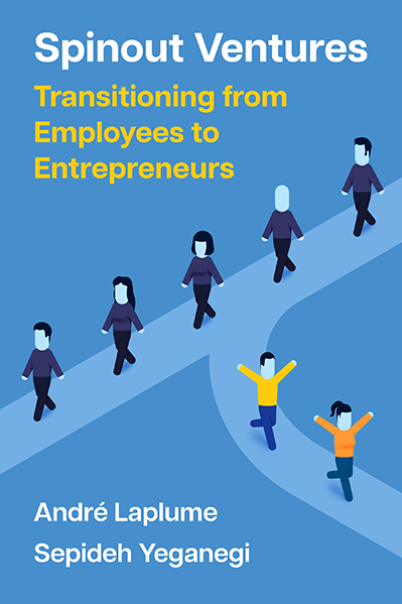(Employee) spinout company versus (corporate) spinoff company: What's the difference?
There exists much confusion about the difference between "employee spinouts" and "corporate spinoffs". It is due to the ambiguous use of these terms both in practice and in academia (Yeganegi et al., 2024).
The following is an attempt to differentiate these phenomena based on who enjoys ownership benefits. At a basic level, spinouts involve employees that turn into entrepreneurs that launch startups, whereas spinoffs are corporate divisions/units turned independent companies.
An Employee spinout ("spinout") is the outcome of the independent decisions of employees that leave their employment to start a new venture or company (i.e., employees-turned-entrepreneurs). Neither the parent organizations nor their investors typically receive any ownership shares in a spinout (although they may sometimes take a small equity stake in exchange for IP rights). Spinouts are owned and controlled by former employees and their own investors (e.g., venture capitalists or angel investors). Spinouts that are not "authorized" or "sanctioned" by their parent organizations may be met with hostility from parent managers and other stakeholders (Walter et al., 2014). Parent organizations may litigate against spinouts for violating fiduciary duties, breaching non-competes, non-solicitations, and non-disclosures, or infringing on intellectual property (e.g., patents). Spinouts may be considered by primary parent firm stakeholders to be disloyal or treacherous, as in the case of the so-called Traitorous Eight. Nonetheless, spinouts led by employees have been among the most successful types of startups (e.g., Zoom, Apple, Intel, and Zillow) owning to the knowledge they transfer from their parents. The most successful spinouts often involve larger founding teams that transfer knowledge and networks with them from their previous employment. Some parent organizations have become friendly toward spinouts to improve their reputation for incubation of innovations allowing them to attract high quality human resources. Adams et al. (2024) show how spinouts do not have to compete with their parents an often instead become customers, suppliers, or partners of their parent organizations.
In contrast:
A Corporate Spinoff ("spinoff") is the outcome of corporate decision making processes of organizations (Agarwal, Audretsch, & Sarkar, 2007). A company's managers decide to make a division or subsidiary of the corporation into a separate legal entity with different (albeit often overlapping) owners. Spinoffs are often used to increase corporate coherence and to give growing divisions the independence they need to flourish. These new entrants can hardly be called startups as many of them have been established businesses for some time. Spinoffs are a type of corporate restructuring decision (divestiture) and a form of corporate entrepreneurship. Owners of shares in the parent receive shares in the spinoff, which is a new legal entity that issues new equity. For example, when eBay spun-off Paypal, a new ticker was issued for Paypal and eBay shareholders each received pro-rata shares in the new company. The actual implementation of a corporate spinoff may vary, for example, a pure-play, split-off, or carve-out.
Notes:
In the education and research industries an "academic spinoff" or "university spinout" usually involves university professors or researchers, but also typically also provides equity to universities or a licensing agreement. There are also public sector spinouts from government research laboratories.
Employee spinouts are related but distinct from hybrid entrepreneurship, which involves working on a startup as a side gig while remaining employed.
Sources:
Adams, P., Bahoo-Torodi, A., Fontana, R., & Malerba, F. (2024). Employee spinouts along the value chain. Industrial and Corporate Change, 33(1), 90-105.
Agarwal, R., Audretsch, D., and Sarkar, M. B. (2007). The process of creative construction: knowledge spillovers, entrepreneurship, and economic growth. Strategic Entrepreneurship Journal, 1(3–4), 263–286.
Laplume, A. O. and Yeganegi, S. (2024). Spinout ventures: Transitioning from employees to entrepreneurs. Business Expert Press.
Walter, S. G., Heinrichs, S., and Walter, A. (2014). Parent hostility and spin‐out performance. Strategic Management Journal, 35(13), 2031-2042.
Yeganegi, S., Dass, P., & Laplume, A. O. (2024). Reviewing the employee spinout literature: A cross‐disciplinary approach. Journal of Economic Surveys, 38(1), 137-167.
Video about the "treacherous eight":
